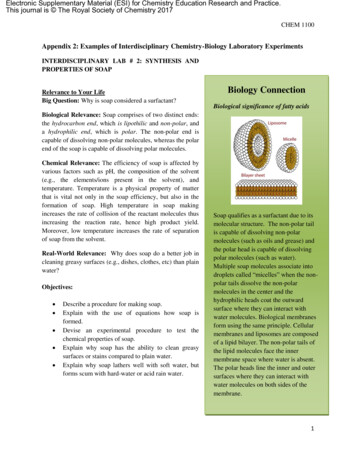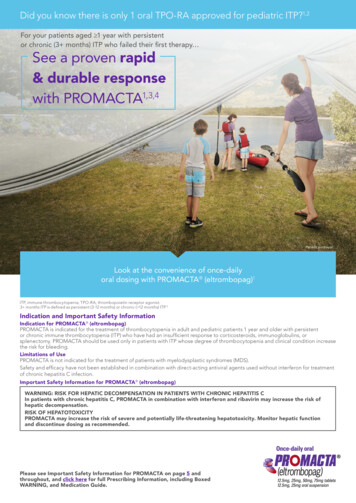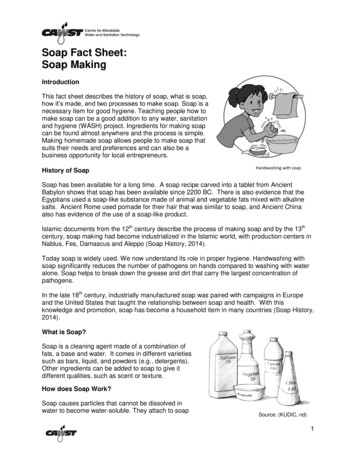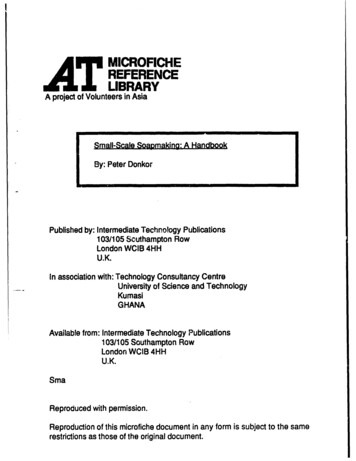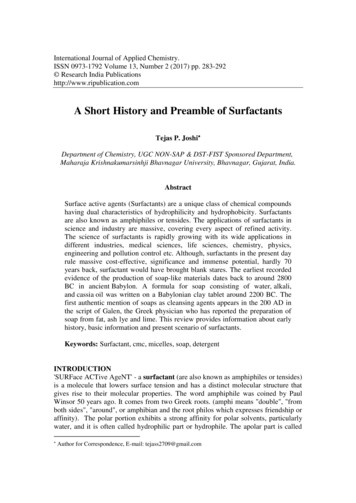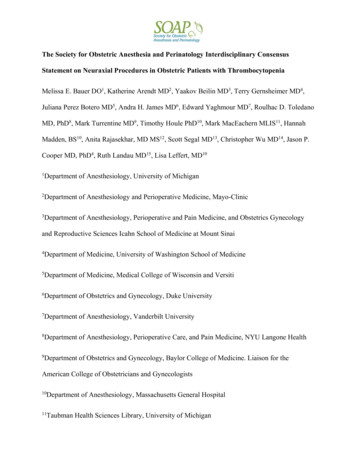
Transcription
The Society for Obstetric Anesthesia and Perinatology Interdisciplinary ConsensusStatement on Neuraxial Procedures in Obstetric Patients with ThrombocytopeniaMelissa E. Bauer DO1, Katherine Arendt MD2, Yaakov Beilin MD3, Terry Gernsheimer MD4,Juliana Perez Botero MD5, Andra H. James MD6, Edward Yaghmour MD7, Roulhac D. ToledanoMD, PhD8, Mark Turrentine MD9, Timothy Houle PhD10, Mark MacEachern MLIS11, HannahMadden, BS10, Anita Rajasekhar, MD MS12, Scott Segal MD13, Christopher Wu MD14, Jason P.Cooper MD, PhD4, Ruth Landau MD15, Lisa Leffert, MD101Department of Anesthesiology, University of Michigan2Department of Anesthesiology and Perioperative Medicine, Mayo-Clinic3Department of Anesthesiology, Perioperative and Pain Medicine, and Obstetrics Gynecologyand Reproductive Sciences Icahn School of Medicine at Mount Sinai4Department of Medicine, University of Washington School of Medicine5Department of Medicine, Medical College of Wisconsin and Versiti6Department of Obstetrics and Gynecology, Duke University7Department of Anesthesiology, Vanderbilt University8Department of Anesthesiology, Perioperative Care, and Pain Medicine, NYU Langone Health9Department of Obstetrics and Gynecology, Baylor College of Medicine. Liaison for theAmerican College of Obstetricians and Gynecologists10Department of Anesthesiology, Massachusetts General Hospital11Taubman Health Sciences Library, University of Michigan
212Department of Medicine, University of Florida13Department of Anesthesiology, Wake Forest University School of Medicine14Department of Anesthesiology, Hospital for Special Surgery, Weill Cornell Medicine15Department of Anesthesiology, Columbia University College of Physicians and SurgeonsCorresponding Author: Melissa Bauer (DO), Department of Anesthesiology, University ofMichigan Medical School, L3627 1500 E Medical Center Dr., Ann Arbor, MI 48109 USA,Email: mbalun@med.umich.edu, Phone: 734-615-2487Funding: This work was supported by the University of Michigan Department of Anesthesiologyand The Massachusetts General Hospital Department of Anesthesia, Critical Care & PainMedicine and supported by T32HL007093 from the NHLBI.Conflicts of Interest: NoneNumber of words:ABSTRACT:As thrombocytopenia in pregnancy occurs in up to 12% of obstetric patients, it is not infrequentthat the obstetric anesthesiologist must consider whether to proceed with a neuraxial anesthesiain an affected patient. Given the morbidity associated with the alternatives, such as generalanesthesia for cesarean delivery, an estimate of the relative risk of spinal epidural hematoma isimportant to consider. Whereas multiple other professional societies (obstetric, interventionalpain, and hematologic) have published guidelines addressing platelet thresholds for safeneuraxial procedures, the U.S. anesthesia professional societies have been silent on this topic.Despite the paucity of high-quality data, there are currently meta-analyses that provide better
3estimations of sample risks. The goal of this interdisciplinary taskforce was to unite the relevantprofessional societies, synthesize the best available data, and provide a practical decisionalgorithm to help inform risk/benefit discussions with patients and aid in shared decision making.Abbreviated Title: Neuraxial Procedures in Thrombocytopenic ParturientsAuthor contributions:Melissa Bauer: This author wrote the manuscript and edited for critical content.Katherine Arendt: This author wrote the manuscript and edited for critical content.Yaakov Beilin: This author edited the manuscript for critical content.Terry Gernsheimer: This author edited the manuscript for critical content.Juliana Perez Botero: This author edited the manuscript for critical content.Andra James: This author edited the manuscript for critical content.Edward Yaghmour: This author edited the manuscript for critical content.Roulhac Toledano: This author edited the manuscript for critical content.Mark Turrentine: This author edited the manuscript for critical content.Timothy Houle: This author edited the manuscript for critical content.Mark MacEachern: This author edited the manuscript for critical content.Hannah Madden: This author edited the manuscript for critical content.Anita Rajasekhar: This author edited the manuscript for critical content.Scott Segal: This author edited the manuscript for critical content.
4Christopher Wu: This author edited the manuscript for critical content.Jason Cooper: This author edited the manuscript for critical content.Ruth Landau: This author edited the manuscript for critical content.Lisa Leffert: This author wrote the manuscript and edited for critical content.Acknowledgments (17):The authors would like to acknowledge the following individuals for completing a surveyregarding neuraxial anesthesia:Klaus Kjaer, MD (Associate Professor, Department of Anesthesiology, Weill Cornell School ofMedicine, New York, NY, USA), Grant Lynde, MD, MBA (Associate Professor, Department ofAnesthesiology, Emory University School of Medicine, Atlanta, GA, USA), Brian Bateman,MD, MSc (Associate Professor, Department of Anesthesiology, Perioperative and PainMedicine, Brigham and Women’s Hospital, Boston, MA, USA), Brendan Carvalho, MD(Professor, Department of Anesthesiology, Perioperative and Pain Medicine, Stanford UniversityMedical Center, Stanford, CA, USA), Paloma Toledo, MD (Assistant Professor, Department ofAnesthesiology, Northwestern Feinberg School of Medicine, Chicago, IL, USA), Heather Nixon,MD (Associate Professor, Department of Anesthesiology, University of Illinois at Chicago,Chicago, IL, USA), Michaela Farber, MD, MS (Assistant Professor, Department ofAnesthesiology, Perioperative and Pain Medicine, Brigham and Women’s Hospital, Boston, MA,USA), Manuel Vallejo, MD, DMD (Professor, Department of Anesthesiology, West VirginiaUniversity School of Medicine, Morgantown, WV, USA) Robert Gaiser, MD (Professor,
5Department of Anesthesiology, University of Kentucky, Lexington, KY, USA), Michelle Simon,MD (Assistant Professor, Department of Anesthesiology, University of Texas Medical Branch,Galveston, TX, USA), Ashraf Habib MB, FRCA (Professor, Department of Anesthesiology,Duke University School of Medicine, Durham, NC, USA), Rachel Kacmar, MD (AssistantProfessor, Department of Anesthesiology, University of Colorado School of Medicine, Aurora,CO, USA), Grace Lim, MD, MS (Assistant Professor, Department of Anesthesiology, Universityof Pittsburgh Medical Center Magee-Women’s Hospital, Pittsburgh, PA, USA), Mark Zakowski,MD (Department of Anesthesiology, Cedars Sinai Medical Center, Los Angeles, CA, USA),Greg Palleschi, MD (Department of Anesthesiology, North Shore University Hospital,Manhasset, NY, USA), Eric Sloan, MD (Assistant Professor, Department of Anesthesiology,Medical College of Wisconsin, Milwaukee, WI, USA), Jennifer C. Gage, MD (AssistantProfessor, Department of Anesthesiology, Larner College of Medicine at University of Vermont,Burlington, VT, USA)
6Why was this consensus statement developed?This consensus statement was commissioned by the Society for Obstetric Anesthesia andPerinatology (SOAP) to address the risks and benefits of performing neuraxial procedures inobstetric patients with thrombocytopenia. Representatives were chosen to provideinterdisciplinary input by the following subspecialty professional organizations: AmericanSociety of Regional Anesthesia and Pain Medicine (ASRA), American College of Obstetriciansand Gynecologists (ACOG), Society for Maternal Fetal Medicine (SMFM), and the AmericanSociety for Hematology (ASH).What other statements or guidelines are available on this topic?There are multiple national subspecialty professional organizations (hematology,obstetric, transfusion medicine) that address the performance of neuraxial procedures inthrombocytopenic patients, but the U.S. anesthesia professional organizations have remainedsilent on this topic.How does this statement differ from existing guidelines?This consensus statement focuses on obstetric patients with thrombocytopenia (defined asplatelet count 100,000 x 106/L), whereas existing guidelines cover a range of other relatedtopics and patient populations, primarily related to lumbar punctures.Glossary of Terms: American College of Obstetricians and Gynecologists (ACOG), AmericanSociety of Regional Anesthesia and Pain Medicine (ASRA), American Society for Hematology(ASH), Society for Maternal Fetal Medicine (SMFM), Society for Obstetric Anesthesia and
7Perinatology (SOAP), Research Electronic Data Capture (REDCap), class of recommendation(COR), level of evidence (LOE), American College of Cardiology/American Heart Association(ACC/AHA), acute fatty liver of pregnancy (AFLP), immune thrombocytopenia (ITP),thrombotic thrombocytopenic purpura (TTP), lupus anticoagulant (LA), anticardiolipin antibody(aCL), antinuclear antibody (ANA), prothrombin time (PT), activated partial thromboplastintime (aPTT), confidence interval (CI), complete blood count (CBC), ethylenediamine tetra-aceticacid (EDTA), thromboelastography (TEG), rotational thromboelastometry (ROTEM), plateletfunction analyzer (PFA-100), intravenous immunoglobulin (IVIG), cyclooxygenase (COX),Collaborative Low-dose Aspirin Study in Pregnancy (CLASP), Society of InterventionalRadiology (SIR), lactate dehydrogenase (LDH), aspartate aminotransferase (AST), alanineaminotransferase (ALT), disseminated intravascular coagulopathy (DIC), magnetic resonanceimaging (MRI), Association of Anaesthetists of Great Britain and Ireland (AAGBI), SociedadeBrasileira de Anestesiologia (SBA), Belgium Association for Regional Anaesthesia (BARA),European Society of Anesthesiology (ESA), Scandinavian Society of Anesthesiology (SCA),AABB (formerly, the American Association of Blood Banks), The Dutch Institute of HealthcareImprovement (CBO), Italian Society of Transfusion Medicine and Immunohaematology(SIMTI), French Safety Agency for Health Products (AFSSaPS), peripheral blood smear (PBS)
8PART I.IntroductionThrombocytopenia in pregnancy, defined as 150,000 x 106/L, occurs in 7-12% ofwomen.1 Obstetric patients with thrombocytopenia are often denied neuraxial procedures due tothe perceived increased risk for spinal epidural hematoma. Opting for general anesthesia ratherthan neuraxial anesthesia can result in severe maternal and fetal morbidity. Maternal and fetalrisk related to general anesthesia are displayed in Box 1. Despite the paucity and low quality ofevidence to guide anesthetic practice, anesthesiologists must make clinical decisions (often withtime constraints) about whether to proceed with neuraxial anesthesia in obstetric patients withthrombocytopenia. This consensus statement was developed to provide the best availableevidence and a clinical decision aide to inform risk-benefit discussions with patients and enableanesthesiologists to engage in effective shared decision-making.MethodsThe taskforce formulated this consensus statement based on a general and systematicreview of the literature, and an extensive modified Delphi process that occurred from January2018 to December 2020. A total of 17 representatives were designated by the Board of Directorsof SOAP and each of the participating subspecialty professional organizations (ASRA, ACOG,SMFM, and ASH). These designees included experts in the hematologic and obstetricimplications of thrombocytopenia in pregnancy, neuraxial anesthesia, and statistical methods.Prospective members were initially contacted by their professional organization to assess theirinterest (all elected to participate), and then received a standard, formal letter of invitation. The
9taskforce members (4 hematologists, 2 obstetricians, 9 anesthesiologists, 1 statistician, 1 librarianscientist) came from 15 academic institutions. An obstetric patient with thrombocytopenia wasinvited to review the decision aid and provided feedback as well.The modified Delphi consensus process included both formal and informal methods. Anextensive risk assessment was done using a Research Electronic Data Capture (REDCap) surveyof taskforce members and 17 additional SOAP-affiliated anesthesiologists chosen to representdiverse geographic and practice settings. A second focused survey was then administered to the 4hematology experts. Surveys available in the literature regarding willingness to performneuraxial procedures in the obstetric patient with thrombocytopenia were reviewed, incorporatedinto deliberations, and are presented in Table 2. Subsequent communications occurred via inperson meetings, telephone meetings, and e-mail communications. Differences of opinion werediscussed, and consensus was attained.Literature and Systematic ReviewThe taskforce reviewed relevant literature to create this consensus statement. The searchstrategy is available in a previously published systematic review and meta-analysis that identifiedall published cases of neuraxial procedures (lumbar puncture; spinal, epidural, combined spinalepidural procedures; epidural catheter removal) performed in diverse populations ofthrombocytopenic patients and subsequent development of spinal epidural hematoma.2 Themeta-analysis found the estimated event rate for all neuraxial procedures in patients with aplatelet count of 75,000 to 100,000 x 106/L within the sample to be 0.097% (95% CI 0.002,0.2%), consistent with previous upper bound estimates in prior studies of thrombocytopenic
10obstetric patients.3-6 Probability mapping across all platelet counts displayed an inflection pointnear 75,000 x 106/L indicating a low probability of events above this threshold in the sample.2Grading of Consensus RecommendationsRecommendations are categorized by Class of Recommendation (COR) and Level ofEvidence (LOE) based on the American College of Cardiology/American Heart Association(ACC/AHA) classification system.7 COR denotes the risk-benefit ratio and strength ofrecommendation [Class I (strong), Class IIa (moderate), Class IIb (weak), and III (no benefit orharm)]. LOE describes the quality of evidence [Level A (high quality evidence from greater than1 RCT), Level B-R (Randomized), Level B-NR (Nonrandomized), Level C-LD (Limited Data),and Level C-EO (expert opinion)]. Two authors (M.B. and K.A.) reviewed the evidence andgraded the recommendations. If disagreements could not be resolved by discussion, a thirdauthor was consulted for resolution (L.L.).BackgroundThrombocytopenia in pregnancy and postpartumThe more common diagnoses of thrombocytopenia in pregnancy include: (1) gestationalthrombocytopenia, (2) immune thrombocytopenia (ITP), and (3) thrombocytopenia associatedwith hypertensive disorders of pregnancy [e.g., preeclampsia; hemolysis, elevated liver enzymes,low platelet count (HELLP syndrome)]. Rarer conditions either associated with pregnancy [(e.g.,acute fatty liver of pregnancy (AFLP)] or not associated with pregnancy (e.g., thromboticthrombocytopenic purpura (TTP) or inherited thrombocytopenia), and sepsis-inducedthrombocytopenia were outside the scope of these recommendations. The incidence andassociated findings of each condition are presented in Table 3. The detailed evaluation and
11workup of thrombocytopenia in pregnancy is outside the scope of these recommendations, buthas been reported elsewhere.1,8The antepartum work-up of thrombocytopenia in pregnancy should include a thoroughevaluation of bleeding history, comorbidities, and medications associated withthrombocytopenia. Platelet count prior to pregnancy and during pregnancy should be evaluated.General bleeding history questions may be falsely positive for at least one symptom in 25-46%of patients without a bleeding diathesis.9 Studies comparing general screening questions onbleeding symptoms administered to controls and patients with Von Willebrand’s disease arevariable in sensitivity for predicting disease.9,10 However, targeted questions addressing familyhistory of bleeding disorders and bleeding after surgical procedures (tonsillectomy, toothextraction) may be useful to detect bleeding disorders.10-12 Specific bleeding risk assessmentmodels have been reviewed and distilled into a set of questions to evaluate bleeding history (Box2).13-15Thrombocytopenia-related Complications of Neuraxial Anesthesia: Spinal Epidural HematomaSpinal epidural hematoma is the thrombocytopenia-related complication of neuraxialanesthesia with the highest morbidity. The incidence in obstetric patients is estimated to bebetween 1:200,000-1:250,000.16,17 However, the incidence of spinal epidural hematomaspecifically in obstetric patients with thrombocytopenia ( 100,000 x 106/L) is unknown. In a2020 systematic review and meta-analysis reviewing 7476 procedures in a cohort ofheterogeneous thrombocytopenic patients (between 1947 and 2018), most spinal epiduralhematomas occurred in patients with lumbar punctures and platelet counts less than 50,000 x106/L.2 Of a total 33 spinal epidural hematomas, within the platelet count ranges of 1–
1225,000 106/L, 26–50,000 106/L, 51–75,000 106/L, and 76–99,000 106/L there were 14,6,9, and4 spinal epidural hematomas, respectively. There were only 5 reported obstetric patients withspinal epidural hematoma with platelet counts between 44,000-91,000 x 106/L (2 after epiduraland 3 after spinal procedures).2 One of the patients had an underlying spinal arteriovenousmalformation and the other was coagulopathic at the time of inadvertent epidural catheterremoval. These were thought to be contributory comorbidities. Of the 3 remaining patients, 2 hadHELLP syndrome and 1 had eclampsia.In that same study, the clinical presentations of spinal epidural hematoma were diverse:the patients had a wide range of presenting symptoms including lower extremity motor deficits13 (59%), back pain 9 (41%), lower extremity pain 2 (9%), lower extremity paresthesia 5 (23%),saddle paresthesia 2 (9%), and urinary or bowel dysfunction 6 (27%). Multiple patients presentedwith more than one deficit. Notably, 18 (95%) were symptomatic within 48 hours of theprocedure. Experts report that prompt imaging and neurosurgical consultation for lumbardecompression is crucial to improve outcomes. It is recommended that patients undergodecompressive laminectomy within 8 hours of onset of neurologic dysfunction, as there isevidence that a higher percentage had full or partial neurologic recovery when laminectomy wasperformed during that time frame.18An additional study analyzing 573 obstetric patients with thrombocytopenia combinedwith 951 cases from the literature reported 1,524 patients received neuraxial procedures withoutdeveloping a spinal epidural hematoma. Although no spinal epidural hematomas were reported,the authors were able to estimate the upper bound risk with 95% confidence intervals (CI) forspinal epidural hematoma stratified by platelet count. For platelet counts between 70-100,000 x106/L, 50-69,000 x 106/L, and less than 50,000 x 106/L, the risk estimates with 95% CI were
130.2%, 3%, and 11%, respectively.19 A more recent study reported an additional 471 patients andfurther reduced the upper bound risk estimates to 0.19%, 2.6%, and 9%.6Laboratory Assessment of Bleeding RiskThe complete blood count (CBC), which provides the absolute platelet count withinapproximately 3% coefficient of variation, can identify which obstetric patients havethrombocytopenia.20 Rarely, a patient may have a spuriously low platelet automated count due toclumping induced by ethylenediamine tetra-acetic acid (EDTA). If there is a spuriously lowplatelet count due to clumping, once the sample has been collected in a tube with an alternativeanticoagulant (e.g., citrate) or counted manually on peripheral blood smear, the platelet countwill be normal.Ideally, additional laboratory testing would assess the interplay between platelet number,platelet function, and other essential coagulation elements to elucidate which obstetric patients areat increased risk for major neuraxial bleeding. The activated partial thromboplastin time (aPTT)and prothrombin time (PT) assays use a phospholipid emulsion instead of platelets to test forinherited or acquired factor deficiencies. Unless an inherited or acquired coagulation defect isknown or suspected, the PT and aPTT have no utility in predicting bleeding risk in a pregnantwoman with thrombocytopenia. Available coagulation tests are summarized in Table 4.Thromboelastography (TEG) and rotational thromboelastometry (ROTEM) are dynamicpoint of care tests that evaluate the viscoelastic properties of blood clots in whole bloodsubjected to rotational forces. While there have been studies reporting the use of ROTEM orTEG (with normal parameters) prior to neuraxial procedures in thrombocytopenic obstetric
14patients without spinal epidural hematoma formation,21,22 other studies in thrombocytopenicpatients have reported no correlation between TEG and ROTEM parameters and clinicalbleeding except at very low platelet counts ( 20,000 x 10 6/L).23,24The platelet function analyzer (PFA-100) tests platelet function by simulating the in-vivohemostatic mechanism of platelet plug formation. Time to formation of the platelet plug is theclosure time (CT). An abnormal CT may be found in patients with thrombocytopenia (platelet 100,000 x 106/L), anemia (hemoglobin 10g/dL), or a significant qualitative platelet defect.However, this test lacks specificity and predictive value for a specific disorder and does notcorrelate with degree of bleeding risk.25 The platelet aggregation test measures agglutination andaggregation of platelets in response to different agonists, but studies evaluating its utility inobstetric patients are lacking.There are several studies that suggest abnormalities in hemostasis parameters such as PT,aPTT, TEG-MA, and PFA-CT in some patients with preeclampsia.21,22,26-33 Some havedemonstrated that compared to patients without preeclampsia, preeclamptic patients with normalplatelet count appear to be hypercoagulable.34,35 Two of these studies highlight a platelet countof 70-75,000 x 106/L as the cut-off below which TEG suggests hypocoagulability.29,31 However,there is a notable degree of inconsistency correlating hemostatic laboratory parameters in thesestudies and lack of data showing correlation between these laboratory tests and the risk of spinalepidural hematoma. Therefore, the expert panel felt that there was insufficient evidence torecommend the routine use of one or more of these laboratory tests in pregnant or postpartumwomen with thrombocytopenia for determination of the safety for neuraxial anesthesia.Platelet transfusion prior to neuraxial procedures
15Some professional organizations recommend administering prophylactic platelettransfusions prior to lumbar puncture for platelet counts ranging from less than 20,000 to lessthan 50,000 x 106/L to decrease the risk of spinal epidural hematoma (Table 1).36-40 However,careful consideration of the associated risks and benefits is required to evaluate whether thisapproach is advisable. A recent Cochrane review found “no evidence from randomizedcontrolled trials or non‐randomized studies on which to base an assessment of the correct platelettransfusion threshold prior to insertion of a lumbar puncture needle or epidural catheter.” 41Further, they suggested that in order to detect an increase in the number of patients with majorprocedure-related bleeding from 1/1000 to 2/1000, the sample size needed would be more than47,000 patients.Platelet transfusion also has associated risks, including transfusion reaction, transfusionrelated acute lung injury, and transfusion-associated circulatory overload. In the UK, 34% oftransfusion related adverse events were due to platelet transfusion.42 Although a transfusedwhole blood unit of platelets is expected to increase the platelet count between 5-10,000 x 106/L,and a pheresis derived bag of platelets is expected to increase the platelet count between 3050,000 x 106/L, increases in platelet numbers are variable in response to transfusions.Furthermore, platelet transfusions may be less effective in patients with preeclampsia or otherdisorders, likely due to platelet consumption.43 There are a few reports of improvement inplatelet count in HELLP syndrome after plasma exchange, but generally not with platelettransfusion alone.44-46 ACOG recommends platelet transfusion in preeclampsia for activebleeding or to improve the platelet count to 50,000 x 106/L prior to cesarean delivery.1For the treatment of ITP in pregnancy, the American Society of Hematology guidelinesnote that platelet transfusion alone is not usually effective, but can be considered with concurrent
16intravenous immunoglobulin (IVIG)47 or corticosteroid therapy.48 However, specific plateletthresholds at which pregnant patients with ITP should be treated were not identified. Accordingto ACOG, in pregnant women with thrombocytopenia, treatment with IVIG or corticosteroids isrecommended if the patient has symptomatic bleeding, for a platelet count less than 30,000 x106/L, and/or to increase to platelet counts considered safe for procedures (e.g., neuraxialprocedures and cesarean delivery).1 Platelet transfusions are recommended to temporize only incases of life-threatening hemorrhage or to prepare for urgent surgery as the response to platelettransfusion is short-lived.1Thrombocytopenia, Aspirin Therapy and Bleeding RiskThe taskforce members concluded that there was insufficient evidence to make arecommendation about performing neuraxial procedures in pregnant and postpartum women withthrombocytopenia taking aspirin. This is a clinically relevant question as ACOG recommends alow dose (81 mg/day) aspirin be administered to pregnant women at high risk for preeclampsiaand be considered for women with one or more of several risk factors for preeclampsia.49 Aspirinirreversibly inhibits cyclooxygenase (COX) required for thromboxane synthesis, subsequentlyreducing platelet aggregation for the life of the platelet. The plasma half-life of aspirin is 20minutes.50 Although the lifetime of the platelet can be up to 10 days, platelet activity is restoredby approximately 10% each day due to platelet turnover. It may take up to 10 days for the entireplatelet population to be renewed; however, normal hemostasis has been shown with as little as20% normal platelet COX activity.51
17Existing professional organization guidelines were reviewed by the panel and noneprovided guidance for the scenario of thrombocytopenia with concomitant aspirin use. There arelimited data that can be gleaned from studies of pregnant women on aspirin although thesepatients did not have concomitant thrombocytopenia. In the Collaborative Low-dose AspirinStudy in Pregnancy (CLASP), 1422 women had epidural procedures while taking 60 mg aspirindaily. None of the patients developed an epidural hematoma.52 In a separate study, the PFA-100was used to analyze platelet function in pregnant women taking aspirin (81 mg). After fourweeks, 25 of 87 women (28.7%) did not have changes in the PFA-100 testing suggesting that notall women have changes in platelet function while taking low-dose aspirin.36 Similarly, a TEGstudy of platelet function did not show any measurable changes in 12 pregnant and 8 nonpregnant volunteers six hours after ingesting high-dose aspirin 600 mg.53In summary, considering the paucity of evidence to guide practice in obstetric patientswith thrombocytopenia and concomitant aspirin use, clinicians and patients should engage inshared decision-making about the perceived competing risks/benefits of proceeding with orwithholding neuraxial anesthesia in cases of severe thrombocytopenia and concurrent aspirin use.Recommendations from other Professional Organizations Regarding Platelet Thresholds forNeuraxial ProceduresObstetric, hematologic, oncologic, radiologic, transfusion medicine, and neurologicalsocieties have made recommendations regarding platelet thresholds for neuraxial procedures.Lumbar punctures had the lowest recommended acceptable range (20-50,000 x 106/L) in order toperform diagnostic lumbar puncture in patients with leukemia or suspected meningitis. 54-57,58Societal recommendations for anesthetic neuraxial procedures most commonly use a limit of80,000 x 106/L.59 However, the Scandinavian Society of Anaesthesiology recommends lower
18thresholds for anesthetic neuraxial procedures that specifically are thought to decrease morbidityand mortality, and for single shot spinal compared to epidural procedures. If the benefit isanalgesia, then the threshold for an epidural procedure is 100,000 x 106/L. 60 The Association ofAnaesthetists of Great Britain and Ireland (AAGBI) is the only society that specifically addressesobstetric patients and provides risk levels of spinal epidural hematoma at various platelet countthresholds for specific disease states such as preeclampsia, ITP, intrauterine fetal demise, andplacental abruption. (Table 1).61PART II.I.Recommendations for Physician Anesthesiologists and other PractitionersThis consensus statement is not intended to set out a legal standard of care and does notreplace medical care or the judgement of the responsible medical professional considering all thecircumstances presented by an individual patient. This statement is not intended to ensure asuccessful patient outcome in every situation and is not a guarantee of any specific outcome.This consensus statement is subject to periodic revision as additional data becomes available. Inall cases it is assumed that the obstetric patients with thrombocytopenia do not have additionalcontraindications to neuraxial anesthesia.The decision of whether to proceed with a neuraxial procedure in an obstetric patient withthrombocytopenia occurs within a clinical context. Potentially relevant factors include, but arenot limited to the following: comorbidities, obstetric risk factors, airway exam, available airwayequipmen
2 12Department of Medicine, University of Florida 13Department of Anesthesiology, Wake Forest University School of Medicine 14Department of Anesthesiology, Hospital for Special Surgery, Weill Cornell Medicine 15Department of Anesthesiology, Columbia University College of Physicians and Surgeons Corresponding Author: Melissa Bauer (DO), Department of Anesthesiology, University of



